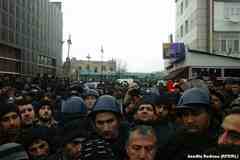Protests in Azerbaijan: A Political and Economic Watershed
Publication: Eurasia Daily Monitor Volume: 13 Issue: 21
By: Zaur Shiriyev
The Jamestown Foundation
Following the devaluation of Azerbaijan’s national currency, the manat, in December 2015—the second in a year—the public has struggled to understand how this policy will affect their daily lives. The impact has become clearer during the first month of 2016: salaries have dropped dramatically, and the prices of essential goods have increased. This came in the face of the government’s promises that the prices of local products would remain stable, and that all necessary measures would be taken to prevent price hikes (Contact.az, January 10). But on the contrary, the economic situation in Azerbaijan has taken a serious turn for the worse.
Panic and frustration led to protests by local populations across several regions countrywide, ranging from hundreds to more than a thousand people, and continuing until January 18–19. What was notable about these protests is that they started out in the regions, without any previous or parallel demonstrations occurring in the capital of Baku. Moreover, the targets of the protests were local executive branches, which people see as responsible for the price hikes and unemployment (APA, January 13). Although the protests are not politically motivated in the narrower sense, and they developed sporadically, the Azerbaijani Prosecutor General’s Office and as well as the Ministry of Interior issued a joint statement accusing the opposition parties and radical and religious extremist groups of organizing the protests (Trend, January 13). Nevertheless, the government has taken some actions in response, including waiving the tax on wheat imports and the sale of bread and flour, as well as increasing pensions and other wages by 10 percent (Azeri Report, January 13; Topnews.az, January 18).
This unexpected emergence of popular unease in the regions is rooted in two key phenomena. Firstly, there has been evident panic about possible price hikes and increasing unemployment since the December 2015 devaluation. The population’s concerns have only increased due to the multiple and often contradictory statements by government officials, as well as the obvious breaches of promises. Essentially, the absence of a clear anti-crisis plan and agenda for economic liberalization has fueled public concern that the government is not acknowledging the reality of the crisis. In this regard, even the implementation of the original 2016 budget is under question, given that there is little hope that oil prices will increase to $40–50 per barrel anytime soon. In fact, only after the outbreak of protests, authorities officially declared that the budget will be adjusted based on projected oil prices of $25 (Vestnik Kavkaza, January 24). Because of this adjustment, the state will not be able to act to prevent the wave of unemployment that independent economists are predicting will rise during this year (Contact.az, January 6). As a result, the public is waiting for the government to announce alternative programs.
The failure to deliver a clear anti-crisis plan has been the crucial factor in the burgeoning unrest. But the second factor explaining the protests is the growing lack of public trust in local authorities. The developments during the last two months have convinced many Azerbaijanis that prospects for economic recovery go against the interests of some officials in various ministries, since those in power are the same people who are suffocating the economy through the failure to implement the decrees that are coming from the top. This loss of trust has been especially marked in the banking and customs sectors. For instance, on January 13, restrictions on duty-free imports were again tightened after having previously been eased (Trend, January 31), which in turn has limited the ability of the population to enjoy imports of some basic goods from neighboring countries.
After the demonstrations ended, on January 18, the government announced that a privatization program will be launched soon, thus opening the economy to foreign investment. The only probable exclusions will be strategic assets such as the State Oil Company of Azerbaijan, SOCAR (APA, January 22). The basic elements of the announced privatization program will be worked out with the aim of implementing “additional measures to extend entrepreneurship, create even better conditions for entrepreneurs, and accelerate domestic and local production” (Trend, January 26). However, to succeed, this program will need to include a detailed plan for economic reform. This is the only solution to the current economic downturn. Yet, it took two years of decline in oil prices for government bureaucrats to publicly acknowledge that there has been no significant diversification in the Azerbaijani economy.
The protests this past month have also exposed the poor implementation of the state program on regional development: for example, during 2004–2014, over $30 billion was allocated for this purpose from the state budget (Azadlig.org, January 15). If the plan had been correctly implemented, the current problems would likely not be so acute, regardless of the devaluation.
The likelihood of further protests will depend on government actions to improve the economy, notably through the implementation of a clear economic reform program that will strengthen the economy in the wake of declining oil prices. At this stage, cosmetic changes are no longer an option for Baku to secure political and economic stability.
The Jamestown Foundation kindly allows Modern Tokyo Times to publish their highly esteemed articles. Please follow and check The Jamestown Foundation website at http://www.jamestown.org/
https://twitter.com/JamestownTweets The Jamestown Foundation
Photo in the original article by The Jamestown Foundation titled “Protesters in Quba, Azerbaijan.”
